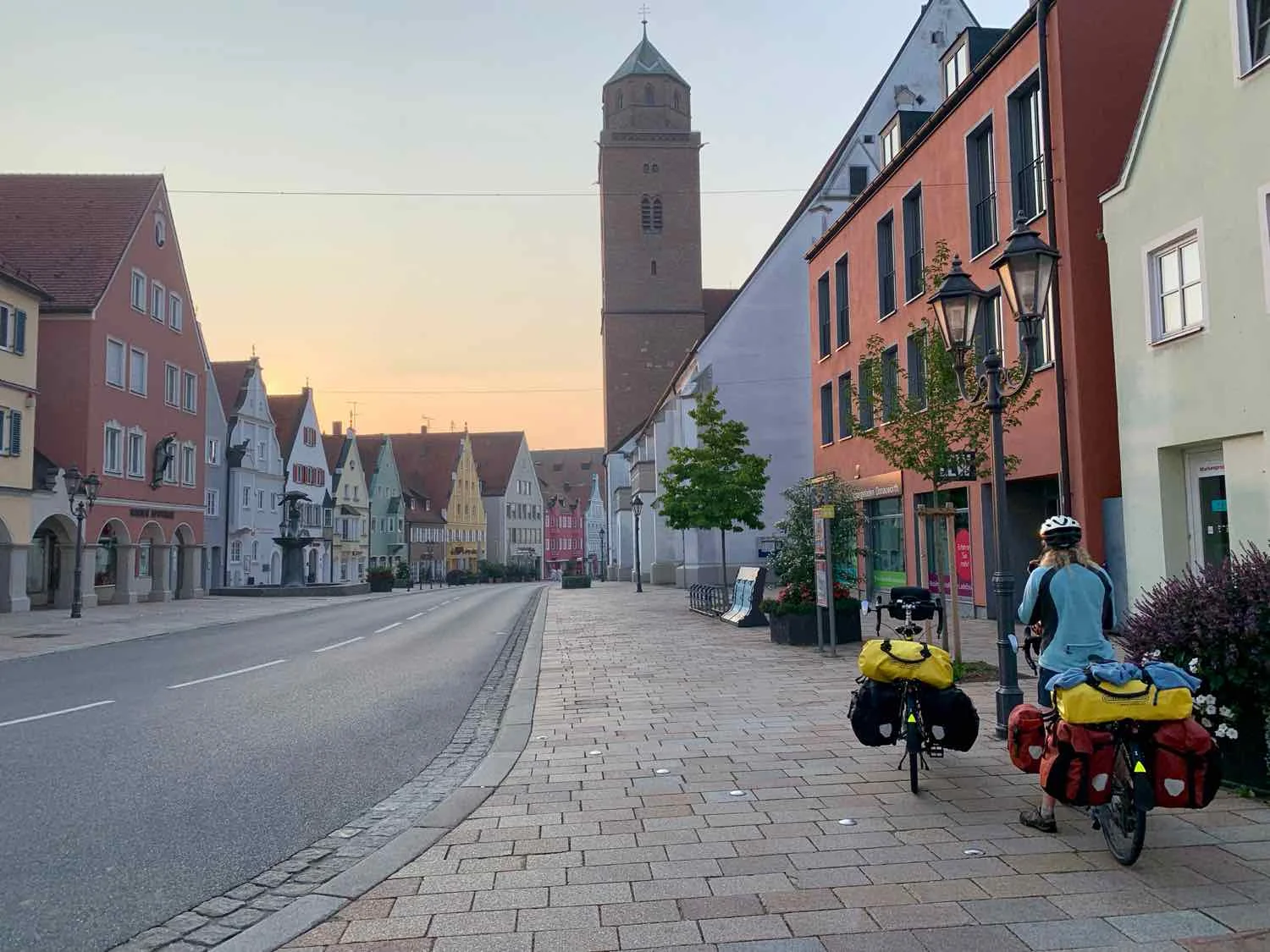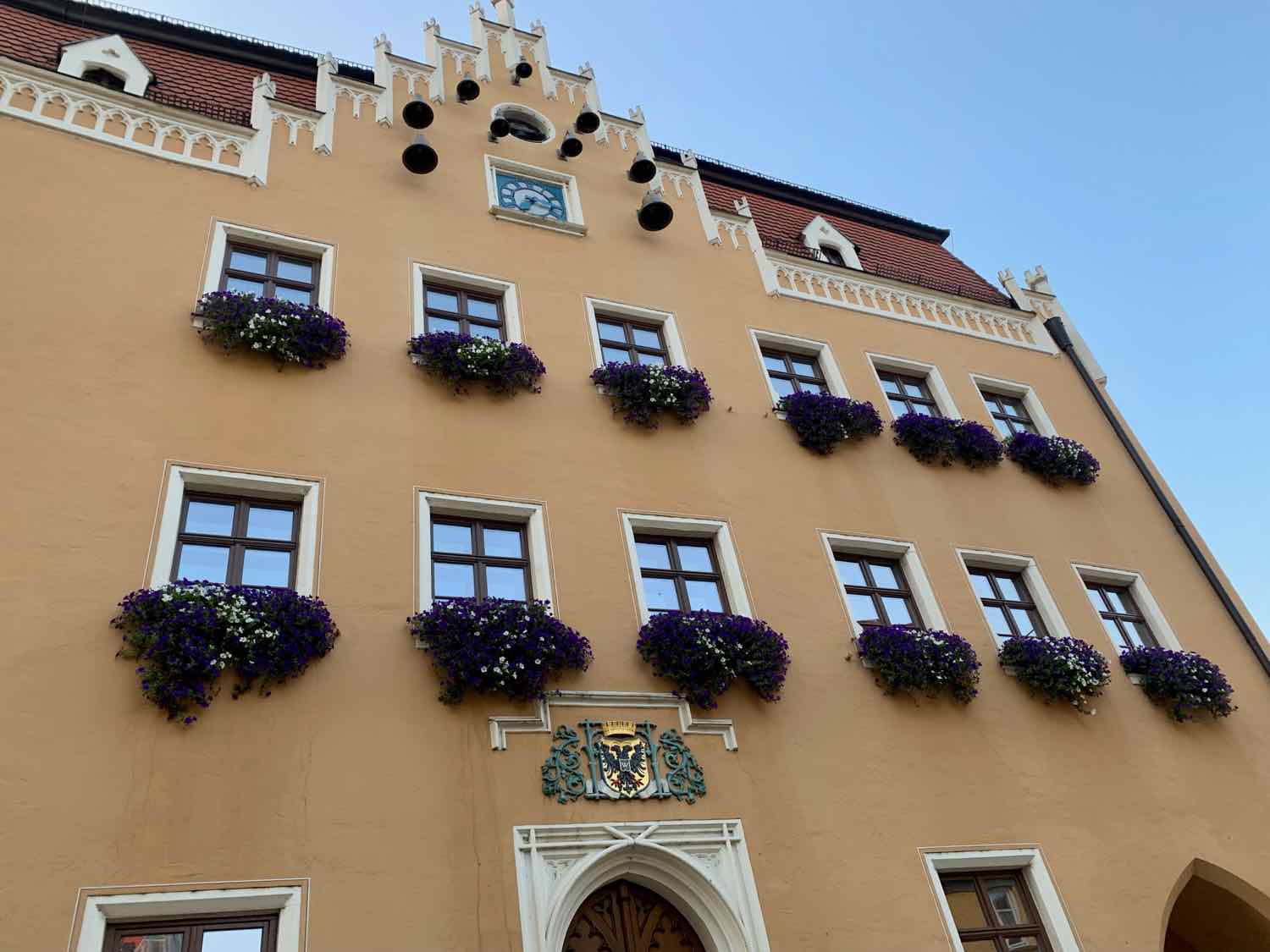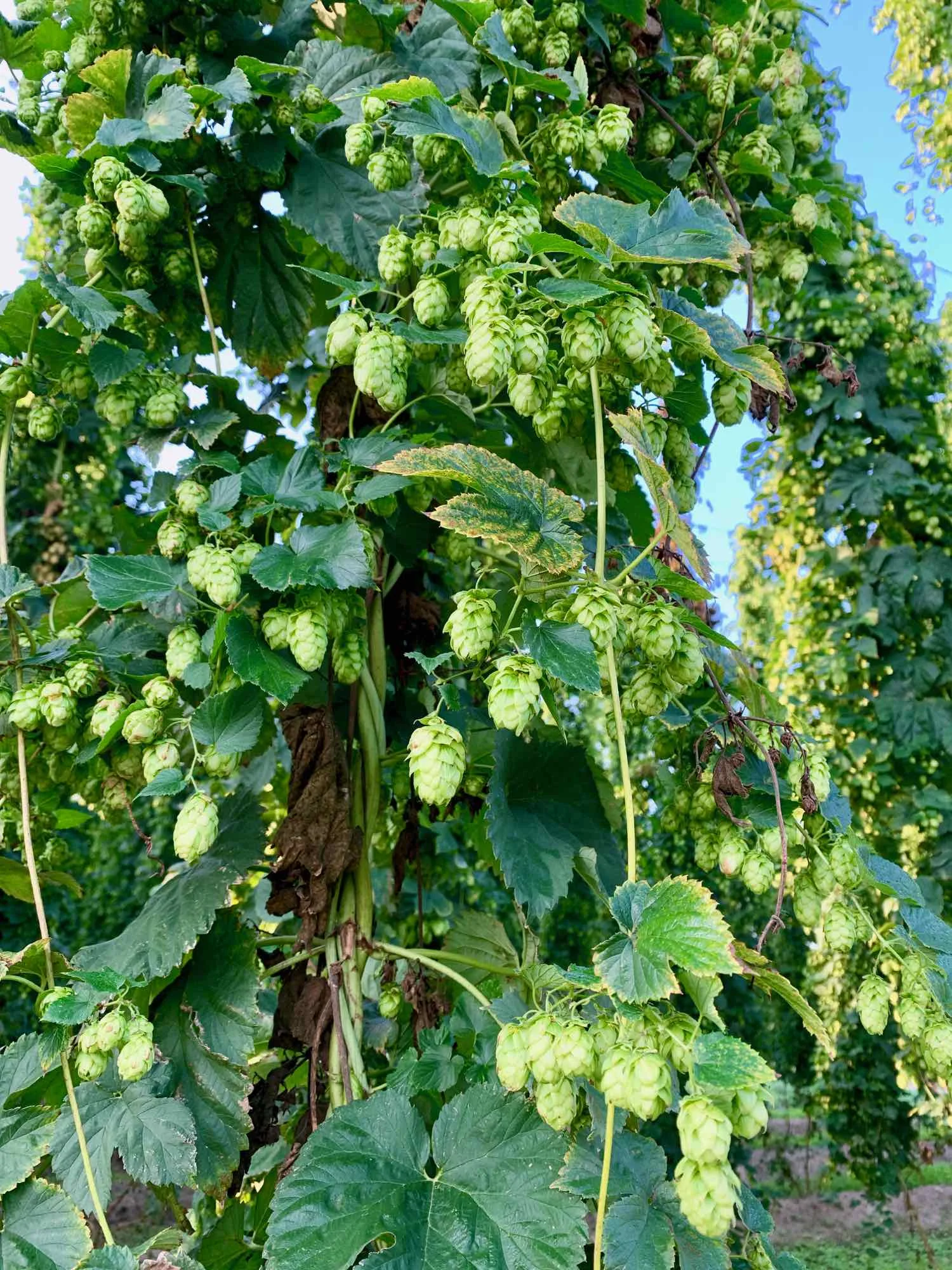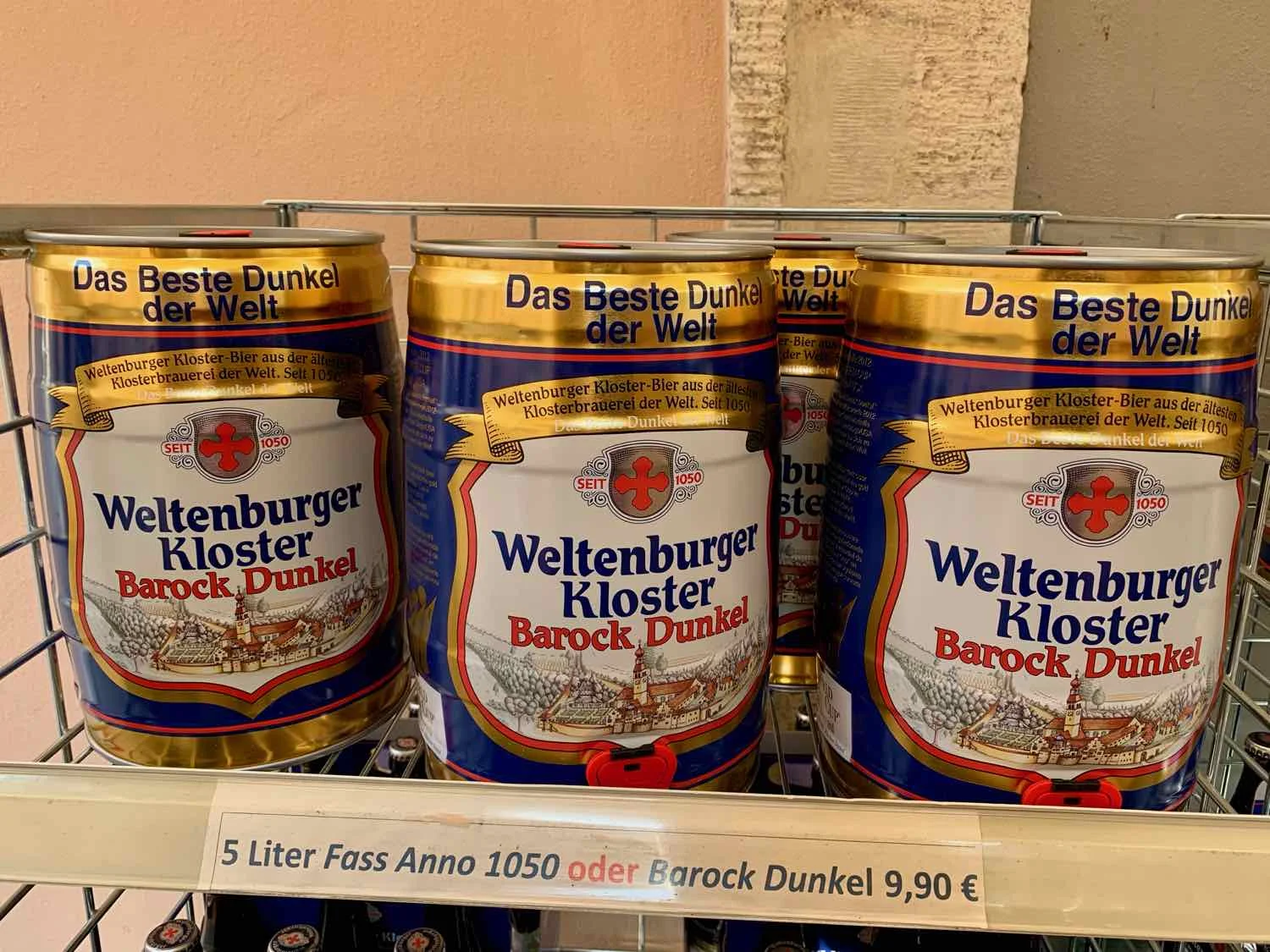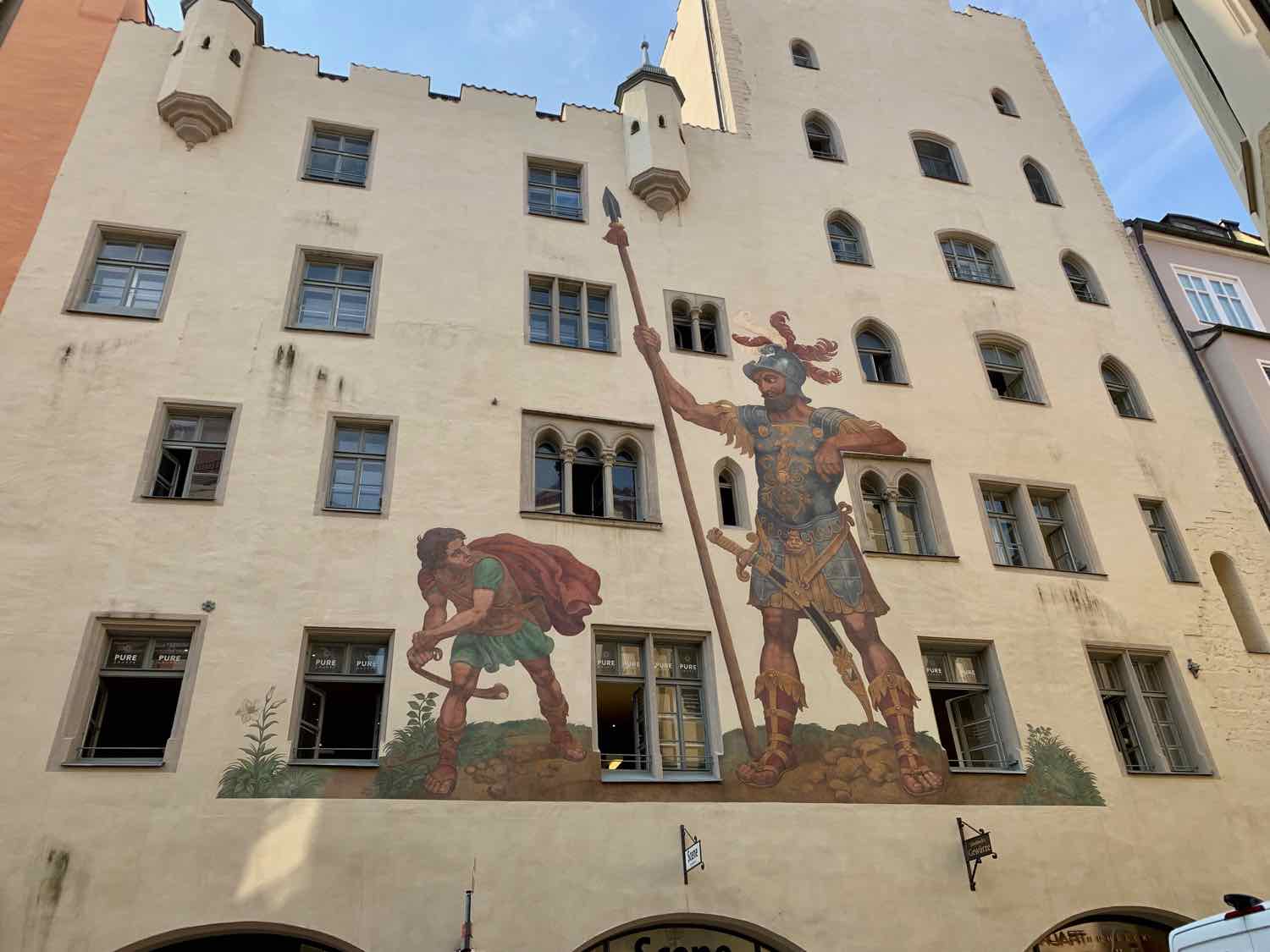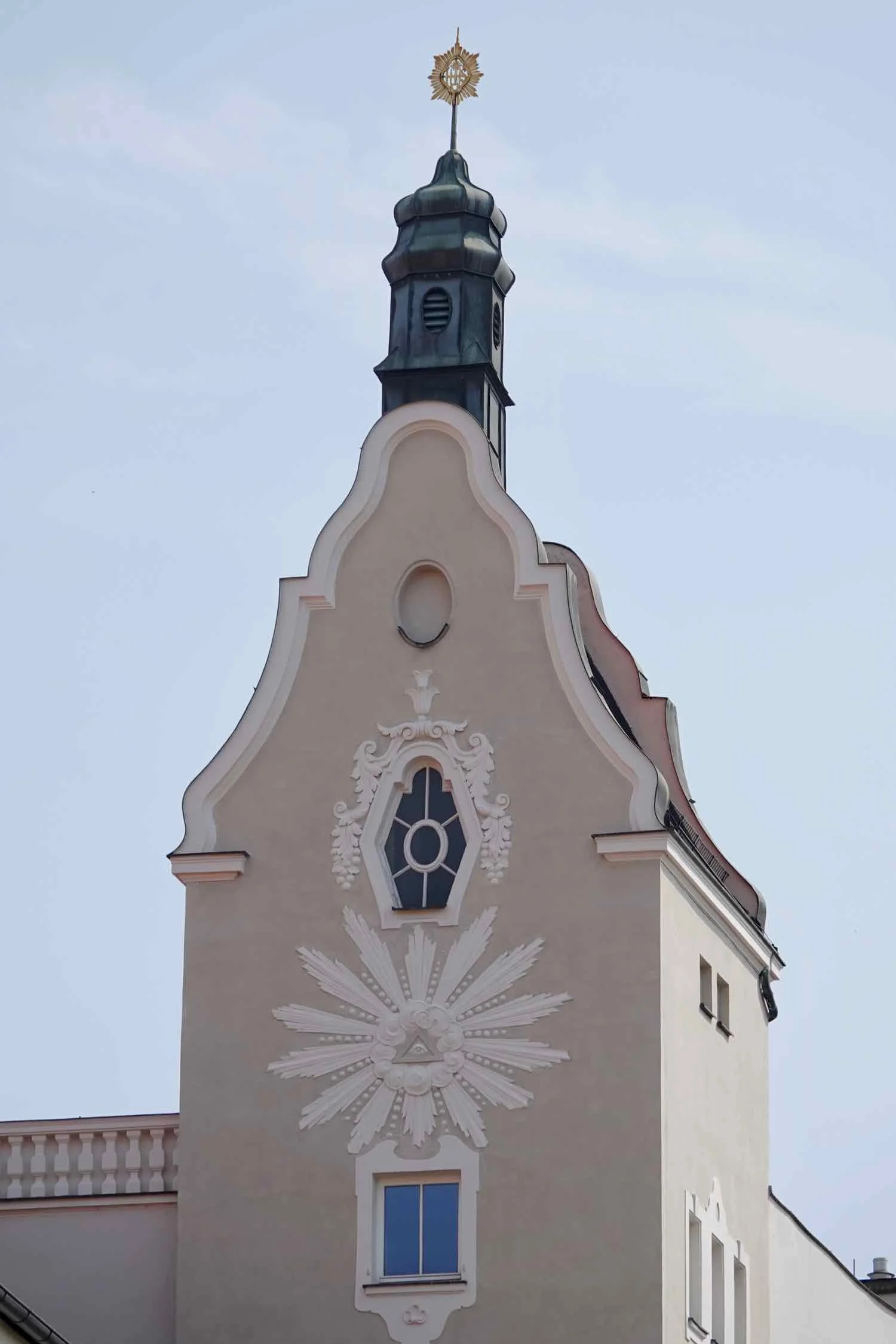Cycling Ulm to Regensburg, Germany: Beer and Cake for Breakfast
24-27 August 2019
Ulm to Donauwörth (24 August 2019 96 km, 59.7 mi)
Leaving Ulm, we cycled through a wide, pancake-flat floodplain for nearly 100 km. The route wound its way through the valley, getting within sight of the Danube River less than half of the time. For the rest of the day, we rode on quiet farm roads through agricultural fields, and passing through the occasional small village.
After about 5.5 km, we entered Bavaria, a region that has strongly influenced how Americans think of Germany. Bavaria is traditionally the land of lederhosen, sausages and beer.
In the village of Faimingen, we stopped to see the remarkable ruins of the Temple of Apollo Grannus. This is the largest Roman temple found north of the Alps, and it encompassed hot springs that were believed to have healing power. Faimingen, Germany. Copyright © 2018-2019 Pedals and Puffins.
Biking through Lauingen, we were captivated by the lovely Schimmelturm tower, which graces the market square. At 54 m tall, it has a commanding presence. The use of frescoes to decorate the base of the tower was a design element we hadn’t seen elsewhere in Germany. Copyright © 2018-2019 Pedals and Puffins.
As fall approaches, piles of colorful gourds are showing up for sale in stores, and even along the roadside. Lauingen, Germany. Copyright © 2018-2019 Pedals and Puffins.
Bride and groom haystacks. Dillingen an der Donau, Germany. Copyright © 2018-2019 Pedals and Puffins.
When we got to Donauwörth, we had to travel about a km off-route to reach the campground where we wanted to stay. Unfortunately, Google’s directions really let us down. The first route it proposed led to a locked gate. Not the kind of gate we could easily get our bikes over, either. So we had to turn back.
The second route Google offered led us to a very long flight of stairs. At least the route went down the stairs, instead of up. And luckily, the stairs had a bike ramp so you could wheel your bike down. It was the longest bike ramp we’ve ever encountered. We decided to go for it, but it was still a huge headache. We couldn’t help but think that there must have been a better route - one where we could have ridden our bikes all the way to the campground.
Hold onto your brakes! Google’s directions took us down one of the longest set of stairs with a bike ramp that we’ve ever seen. Donauwörth, Germany. Copyright © 2018-2019 Pedals and Puffins.
The campground is right next to a stream that feeds into the Danube, and it’s run by a canoe club. When we arrived, there were still quite a few people on paddle boards and in kayaks returning to the club after being out on the water. But most of the tents in the campground belonged to cyclists.
It was pretty late in the day by the time we went looking for dinner. We decided to keep things simple, and go to a Subway that wasn’t too far away. One of the big advantages of eating at Subway for a thirsty cyclist is that they usually have all-you-can-drink fountain drinks, which are rare in Europe. But when we arrived, there was a telltale, hand-written note on the door. The restaurant was closed for two days, due to illness of the proprietor. Rats. That reminded us of France (and not in a good way). We were hungry and thirsty.
We headed down to the main road through the old town, and settled in at one of the open-air restaurants. We had a nice, pleasant, Italian dinner (pasta and pizza) in the heart of Germany.
The restaurant where we had dinner, overlooking a branch of the Wörnitz River. Donauwörth, Germany. Copyright © 2018-2019 Pedals and Puffins.
From our table at the restaurant, we had a fabulous view of the terra-cotta colored Rieder Tor Gate, one of the original entry points into medieval Donauwörth. Under the bridge to the Gate was a steep, stone embankment leading down to a canal. As we waited for our dinner, we were entertained by a bunch of pigeons that had landed on the embankment, and were ever-so-slowly working their way down to the water for a drink. It was a slippery and precarious journey for those pigeons, and it took each one a really long time to safely make it to the water’s edge for a drink.
The lovely Rieder Tor Gate into old town, Donauwörth, Germany. We had fun watching a group of pigeons inch their way down the stone bank under the bridge, to take a drink. Copyright © 2018-2019 Pedals and Puffins.
After dinner, we were still really thirsty. So we decided to make the 15 minute trek to a Burger King, where we hoped to get free refills on drinks. To our dismay when we got there, this Burger King didn’t offer free refills. Neither did the McDonald’s next door. We had an unsatisfyingly small drink at the McDonald’s, then headed back to the campground for the night.
Donauworth to Neustadt (25 August 2019, 98.5 km, 61.2 mi)
We were up before the sun and were treated to a lovely, misty morning view of Donauwörth’s Benedictine abbey in he distance.
Morning mist at campground, with a historic abbey in the background. Donauwörth, Germany. Copyright © 2018-2019 Pedals and Puffins.
Donauwörth’s medieval old town was particularly attractive in the early morning light. We cycled down the picturesque Main Street, and past the Rathaus (city hall).
Along this stretch of the route, the shrines at Jakobsweg rest stops have gotten much more elaborate. Many of them now have small chapels, with altars inside. The altars are decorated with religious statues, candles, and bouquets of bright, artificial flowers.
Now that we’re in the latter part o summer, flower gardens are looking particularly spectacular. Altisheim, Germany. Copyright © 2018-2019 Pedals and Puffins.
Morning mist in the forest. Copyright © 2018-2019 Pedals and Puffins.
Entering the village of Bertholdsheim, a strange structure caught our eye. An extremely tall pole had been erected in a small park. It was topped with what looked like a dead Christmas tree, and hung with several dried wreaths that were adorned with ribbons. Intrigued, we detoured down the side road to the pole, and checked out the sign nearby. The text on the sign wasn’t particularly illuminating. It spoke earnestly about the importance of maintaining traditions as a link between older and younger generations. We suspected it was a maypole, but didn’t know for sure.
Later we learned that yes, it was in fact a maypole (or Maibaum in German). Villages throughout Bavaria and Baden-Württemberg still observe this pagan ritual to celebrate the arrival of spring. In many towns, the poles are taken down by mid-June, but some towns leave them up much longer - like to the end of August.
Each year a new tree is selected, cut down, and hoisted up by the men of the community on May 1 or the day before. The thing that looked like a dead Christmas tree at the top was part of the original tree’s foliage that was left on for decoration. The hoisting of the maypole is accompanied by much eating, drinking, music and dancing, with many parties lasting all night long. Another tradition is the stealing of maypoles by other villages, requiring round-the-clock security for the pole. If a pole is successfully stolen, the town that lost its pole usually has to pay a huge ransom in the form of food and drink. So, towns are very serious about protecting their poles before the hoisting, and for several weeks after.
The first maypole we saw, in Bertoldsheim, Germany. Copyright © 2018-2019 Pedals and Puffins.
Later in the day, we encountered several more maypoles along the route. Many looked a lot like the one in Bertoldsheim, but some were also decorated with images of the town’s businesses. That’s apparently another tradition that goes back for centuries.
The bridge over the Danube River into Neuberg an der Donau is quite impressive. Lined with marble statues, the bridge leads up to one of the old city gates, with an Italian-style palace just behind it. Germany. Copyright © 2018-2019 Pedals and Puffins.
And just outside of Neuburg, we passed the Schloss Grünau, a hunting lodge used by the ruling Counts of Neuburg in the 16h-17th centuries. It’s now a cultural center. Germany. Copyright © 2018-2019 Pedals and Puffins.
We had planned to stay at a municipal campground in Inglostadt, with the appealing name of Radwanderer (bicycle tourer). But when we arrived at the site, it was crowded by day users having barbecues and launching boats. We didn’t really feel comfortable pitching our tent and leaving our stuff unattended with all the people coming and going. So, we decided to keep going another 15 km, for another long day.
The campground in Neustadt was totally different. It was right next to a busy road, so it was probably going to be a noisy night. But it had a some of the swankiest bathroom and shower facilities we’ve ever seen in a campground. The shower area was like a spa. It had clearly been built or renovated very recently. The floors and walls were all covered with high-quality tiles. The fixtures all seemed new. And, most impressively, the shower stalls were designed to keep the water inside. Even the floor outside the shower stayed dry. That is truly a rare thing. We both enjoyed cleaning up after our long day on the bikes.
We spent the end of the evening getting dinner in the small town of Neustadt. We settled in at a table on the main square, in the shadow of Neustadt’s City Hall. Germany. Copyright © 2018-2019 Pedals and Puffins.
Neustadt to Regensburg (26 August 2019, 62 km, 38.5 mi)
Today was a shorter riding day, and we were happy that we didn’t have to hurry. Not long after leaving the campground, we found ourselves cycling through large fields of an interesting plant, growing in tall, straight lines along long racks made of strings. On closer inspection, we saw that these were hop plants, one of the main ingredients of beer. Of course, that makes sense now that we’re in Bavaria. More than 14,000 hectares of hop fields are grown in Bavaria, almost 75% of the crop grown in Germany.
We had thought we might get breakfast in the town of Staubing, 11 km into our ride. But on arriving, we discovered that the town does not have any stores. Instead, there was a little, wooden stand by the side of the road selling Bavarian wassermelones (watermelons). It was self-serve, with a small box on the table for depositing cash. We decided to get one. But they’re VERY heavy for their size, so our plan was to find a place to eat it as soon as possible.
The little wassermelone stand. Staubing, Germany. We picked out one that looked particularly juicy. Copyright © 2018-2019 Pedals and Puffins.
Luck was with us. Just down the road, there was a picnic table. Perfect. As we rode up, another cyclist, riding solo, was just getting ready to leave. We invited him to stay and join us for watermelon, because there was easily enough for three. He accepted our invitation.
His name was Paulo, and he was from a small town near Barcelona, Spain. He has biked the French Route of the Camino de Santiago before - starting in Pamplona. He actually wasn’t that familiar with the route that we had taken, the Via de la Plata, so we shared some of our impressions of that route with him.
On this trip he had started at the source of the Danube in the Black Forest, and hoped to go as far as Budapest. In reality, he would just go as far as he could with the time he had available. His plan is to finish the route all the way to the Black Sea someday. But he would have to do it in segments, because he couldn’t set aside enough time to ride the whole length at once.
We had been to Barcelona a number of years ago. So, we shared with him some of our memories, like watching the Castellers build “human towers” in the main square, It was fun to visit with Paulo, before we all headed off down the road.
Within 2.5 km of leaving Staubing, we arrived at the Weltenburg Abbey (Kloster Weltenburg). There has been an abbey on the site since the early 5th century, making this the oldest monastery in Bavaria. At first we rode by the abbey, and headed towards the Donaudurchbruch gorge. The gorge is a very scenic, narrow gap created by the Danube when it cut through a mass of mountains called the Franconian Jura (nicknamed the Bavarian Alps, but not that high here). Through the gorge, the Danube reaches it’s deepest and narrowest point in Germany.
We rode past the entrance to the monastery, taking a moment to peek through a keyhole in the walls to see the garden. Weltenburg Kloster, Germany. Copyright © 2018-2019 Pedals and Puffins.
But pretty soon we discovered that you can’t bike through the gorge. It’s too narrow and steep, and there are no roads or trails through it. It turns out that EuroVelo 6 requires a ferry trip through the gorge. So we headed back up the road to get a ferry ticket.
Back at the abbey, we learned that it is also famous for brewing beer. There’s been a brewery at the abbey since 1050 AD, making it the oldest monastic brewery in the world.
We figured we might as well have one of those famous beers while we waited. Who wouldn’t? We settled into the abbey’s restaurant and ordered a Kloster Weltenburg dunkel, their most popular beer, plus a slice of multi-berry cake to share. If that doesn’t sound appealing, you’d be surprised how well the two went together. The dunkel was a very dark beer, but incredibly smooth. We both thought it was one of the best beers we’ve ever had.
Beer and cake for breakfast. Weltenburg Kloster, Germany. Copyright © 2018-2019 Pedals and Puffins.
After the beer and cake, we visited the inside of the abbey’s church. It’s a baroque masterpiece, completely decked out with flamboyant carvings, statues and frescoes depicting religious themes. It’s jam-packed with images. In just one visit, it’s hard to take it all in. But we’re glad we were able to see it in person.
Inside the church at the monastery. Weltenburg Kloster, Germany. Copyright © 2018-2019 Pedals and Puffins.
By the time we had finished our meal and visited the church, we had to hustle over to the ferry landing to catch our ride. We just made it, and we were the last people to board the boat before it headed down the river.
Boarding the ferry. Klösterl, Germany. Copyright © 2018-2019 Pedals and Puffins.
The trip through the gorge was lovely. There was easy-to-hear narration in both German and English, which was great. They mentioned how there used to be a Roman fort on the top of one of the cliffs, and pointed out various rock formations and statues that could be seen along the way.
Heading into the Donaudurchbruch Gorge, Danube River, Germany. Copyright © 2018-2019 Pedals and Puffins.
Inside the gorge, we were impressed to see some rock climbers ascending the cliff. At their highest, the cliffs rise for about 100 m. That’s a pretty long climb.
On the far bank, on top of a hill, we had striking views of Liberation Hall in the sunlight. The monument was built by King Ludwig I of Bavaria to commemorate the victory over Napoleon in 1815. Donaudurchbruch Gorge, Danube River, Germany. Copyright © 2018-2019 Pedals and Puffins.
By the time we reached the ferry’s landing in Kelheim, on the other side of the gorge, it was noon - and we’d only biked about 15 km. It was time to get moving.
Exiting through the city gate. Kelheim, Germany. Copyright © 2018-2019 Pedals and Puffins.
Luckily the rest of the ride to Regensburg was almost all flat, and the kilometers went by quickly.
The lion seemed to be keeping an eye on us as we rode by. I thought it might be best to keep an eye on him as well. Bad Abbach, Germany. Copyright © 2018-2019 Pedals and Puffins.
Regensburg Rest Day (27 August 2019)
Regensburg is famous for having a very well-preserved, medieval, old-town. We decided to stay an extra day, to visit some of the city’s top tourist sights. But even though much of the city’s layout and structure is very old, the city itself feels quite new. It doesn’t have the same kind of ancient ambiance as, for example, Cáceres, Spain.
We started out with a walk to the city’s main Cathedral. Regensburg, Germany. Copyright © 2018-2019 Pedals and Puffins.
Statue of King Ludwig I of Bavaria, in the cathedral plaza. Regensburg, Germany. Copyright © 2018-2019 Pedals and Puffins.
Outside the cathedral, we saw a tour bus and decided to take the city tour. It was the quickest and easiest way to get a feel for all of the major sights. Regensburg, Germany. Copyright © 2018-2019 Pedals and Puffins.
The Old Town Hall, where the Imperial Diet (assembly) for the Holy Roman Empire met for 200 years. Regensburg, Germany. Copyright © 2018-2019 Pedals and Puffins.
Rococo facade of the Maximillian Hotel. Regensburg, Germany. Copyright © 2018-2019 Pedals and Puffins.
In the end, we felt like Regensburg was an interesting city that isn’t really like most of the other medieval, European cities. We’ve grown used to the historical sights having a musty, old ambiance. Regensburg, on the other hand, feels fresh and modern. Even in the oldest parts of town, where streets are narrow and covered with cobblestones, the buildings all have a fresh coat of paint, and they aren’t crumbling around the edges. It gave us a new perspective on how a really old city can thrive, while preserving elements of its past.

